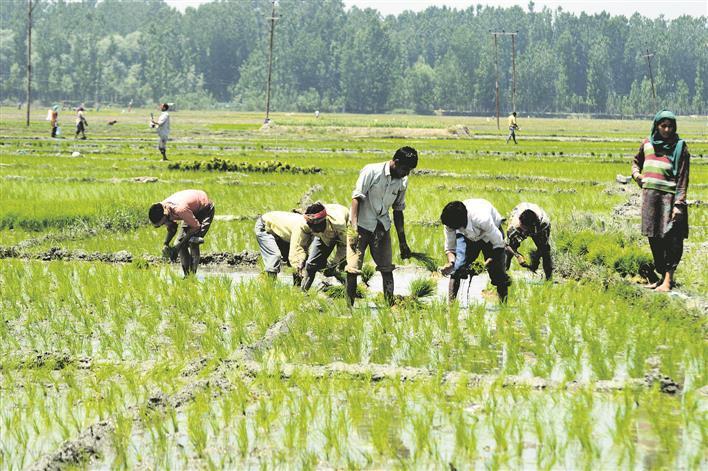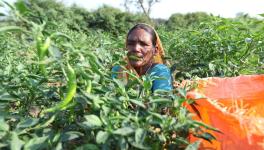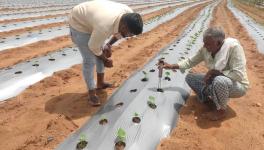Marketing of Agricultural Produce and Role of MSP

Image Courtesy: Tribune India
As we all know, the many positive steps on all fronts of the country's agricultural economy have resulted in agrarian revolutions--green and white. The productivity and production of different crops and allied sector products in various states have shown an unbelievable increase. Naturally, the marketing of products became a crucial problem of Indian agriculture at a point in time. In facilitating the sale-purchase of products, the marketing system rendered valuable service to the economy on several counts -- functioning of the economy, economic development, promotion of people's well-being etc.
The system of marketing of agricultural produce, however, encountered certain serious shortcomings such as i) inadequate storage, ii) inadequate means of transport, iii) inadequate credit facilities, iv) lack of grading and standardisation, v) non-availability of market information, vi) malpractices of buying and selling because of a large number of intermediaries and vii) inadequacy of institutional marketing. The consequences have been meagre earnings, little incentive, low marketable surplus, obstruction to innovative farming, and difficulties in planning.
Such revolutionary increase in productivity and production necessitated good market infrastructure and an appropriate price policy of farm produces in the country to enable the farmers to sell the produce at reasonable prices. Steps were taken to establish Mandis and Krishak Bazars with improved marketing facilities not only in agriculturally rich states but also in almost all the states. States had provided market facilities as best as possible by making legislation, where necessary, with their own initiatives. In the 1970's, the agricultural markets in different states were being operated as regulated markets with market yards and other infrastructural facilities.
At the beginning of this century, the UPA government felt the necessity of bringing about reforms in the marketing of farm produce. The Government of India prepared a model law called The State Agricultural Produce Marketing (Development and Regulation ) Act, 2003 and requested the states take up necessary reforms by enacting the legislation accordingly. Most states took up reforms as per the model Act, and the Agricultural Produce Marketing Committees (APMCs) were constituted to operate with the defined jurisdictions. Punjab, Haryana, Maharastra, Tamil Nadu, and Andhra Pradesh -- the states known as granaries of the country -- operated APMC markets by the name Mandi or Krishak Bazar. Mandis in Punjab and Haryana are so famous that farmers from the neighbouring states of UP and Rajasthan also come to these markets with truck and tractor loads of agricultural products. Maharastra has 307 and Tamil Nadu has 277 APMC Marketing Committees operating for a long time. The West Bengal Government has since completed the construction of 186 market buildings, yards and other infrastructures with RKVY funds of more than Rs 1000 crore. However, only a few have started full capacity operations. In fact, all the states strengthened their marketing infrastructure with the help of GoI's RKVY and Cooperative Funds. It is to be noted that the country has now a cold storage capacity of 3,67,70,637 metric tonnes of food grains.
Along with the infrastructure building programme, the Government of India followed the policy of market intervention by fixing MSP to extend protection to the farmers and not allowing the prices to face sharp falls. The MSP became the major component of the price policy envisaged by the government. Thus, the government's policy for agricultural prices has been pursued with clearly defined objectives of:
- Encouraging production by assuring the producer that the prices of the produce will not fall below a certain minimum.
- Ensuring relevant income levels of the farming community, the emphasis being on reasonable terms of trade between agricultural and non-agricultural sectors.
- Protecting the interest of consumers by preventing an excessive rise in prices.
- Ensuring stability in prices to introduce certainty in the price situation in the agricultural sector and the economy as a whole.
The instruments used are: i) MSP and procurement prices that provide minimum support guarantee to the producers in the event of a glut, ii) issue prices for the public distribution system, and iii) maintenance of prices through buffer-stock operations.
This government policy took a firm shape with the inception of the Agricultural Costs and Prices Commission(CACP) in 1965. The Commission's terms of reference were to provide 'advice on a continuing basis on agricultural price policy and price structure in the context of the need to raise agricultural production and give relief to the consumers.' The thrust was to 'evolve a balanced and integrated structure in the perspective of the overall needs of the economy.' The price policy, implemented through applying the above-stated instruments supplemented by imports when necessary, has acted as a well-set design where MSP has played a crucial part.
Evaluation of Policy:
The price components of minimum support price (MSP), procurement price and issue price, have borne upon production, securing surpluses (procurement price), and distribution or meeting the needs of consumers (issue prices). The procurement agencies like the Food Corporation of India (FCI) and the fair price shops under the Public Distribution System have backed the implementation of the price policy. One of the impacts has been that the prices of agricultural products have risen faster than the prices of non-agricultural products. Between 1965-66 (pre-CACP) and 1974-75 (post-CACP period), the price rise of agricultural products, estimated at 9.54%, was faster than that of non-agricultural products at 7.84%.
Moreover, the difference in the rate of price increase of agricultural products has been more in the post-Commission period at 5.56% than 4.13% in the pre-Commission period from 1955-56 to 1964-65. This trend of a faster rise in agricultural prices compared to industrial prices prevailed in the 1980's and 1990's. The agricultural price index as a percentage of the manufacturing price index rose from 103.7 in 1982-83 to 108.5 in 1990-91, and further to 115.5 in 2000-01 and 116.8 in 2003-04.
The effects in terms of trade have, however, been mixed. This was favourable to agriculture during the mid-sixties. But from the mid-seventies, the price index of agricultural products rose by 100 in place of 150 for manufactured products. The ratio of the price index of agricultural to manufactured products was 97.5 in 1977-78, 95.8 in 1978-79 and 87.6 in 1979-80. However, this trend was reversed in the 1980s in the range of 104-114 with some fluctuations. This favourable agriculture trend became steady in the 1990s, rising to 116 in 2000-01.
So far as price stabilisation is concerned, not much can be said. There have been fluctuations in the short term prices because of supply fluctuations. Generally, prices have been at the lowest at the time of harvesting rice, jowar, bajra and groundnut, a part of which is subjected to distress sale to meet the cash needs and a significant portion of the product (55% to 74%) is sold within six months of the harvest for non-availability of adequate credit and storage facilities. The fluctuations experienced were moderate in the case of products like wheat, partly because the producers were wealthy and had good holding power and better financial/storage capabilities. Crops like pulses and oilseeds have suffered due to the lack of adequate price support. Medium-term prices have been helpful in investments/ technological improvements in a number of HYV crops for several years. The high prices of wheat have also led to the diversion of land from other crops to wheat.
It has been observed that the increase in the production of crops, caused by non-price and price factors, has contributed to the marketable surplus procured on the government account. Procurement was just 5% of net production in 1965, which increased to 16% due to the increase in output and attractive procurement prices. Price policy has helped raise the farmers' income by increasing production, changeing cropping patterns in favour of profitable crops, and higher prices. Consumers, too, have benefitted by way of the PDS operating through fair price shops at issue prices, which are lower than market prices.
A sustained economic growth, rising per capita income, growing urbanisation etc. caused a shift in consumption patterns favouring high-value food commodities like fruits, vegetables, dairy, poultry and fish products, meat and processed food from the staple food such as rice, wheat and coarse cereals. This was towards the beginning of this century. The above-mentioned factors, along with infrastructural development, decreasing impact of the Green Revolution, and liberalisation, triggered the process of agricultural diversification. Rising exports of high-value agricultural products (Rs 1415 million in 2000 in place of Rs 430 million in 1980 in US dollar) also harnessed the diversification process.
The changing agriculture scenario forced the farming community and policymakers to search for a more remunerative and viable production portfolio. The policymakers with such realisation gave maximum emphasis on diversification and brought the high-value products under MSP coverage. That this price policy has helped agricultural sector is evident from the analysis of sources of agricultural growth as the share of different commodities by the researchers.
One of such studies made by PK Joshi (ref. 'Crop Diversification in India: Nature, Patterns and Drivers', Agriculture, Food Security and Rural Development, Vol.3, Asian Development Bank) may help to understand the relative importance of the factors that contributed to the agricultural growth. The study spanned over 20 years and was divided into two decades, i.e. 1980-81 to 1989-90 and 1990-91 to 1999-2000 for mainly two reasons - i) the impact of the Green Revolution started fading since the late 1980s and ii) second-generation agricultural reform started in 1990s, coinciding with the establishment of WTO regulations in the agricultural sector. Based on GOI data, the study found out the effects of area, yield, price and diversification on agriculture growth during the periods under study. It came out that the share of real prices of all cereals (MSP of rice and wheat and increasing demand in the case of fruits and vegetables) turned out to be positive in the 1990s, contributing substantially to agricultural growth. The contribution of output prices and crop diversification went up to the development of agriculture during the reform period. The situation has continued to be so. Instead, the importance of diversification and prices has increased over time.
From the deliberations above, we should very well realise why there is so much clamour for MSP from all the agriculture sector stakeholders in India. The system, however, calls for improvement.
The government announced minimum support prices (MSPs) for 22 mandated crops and fair and remunerative prices (FRP) for sugarcane. The mandated crops are 14 crops of the Kharif season, six rabi crops and two other commercial crops. In addition, the MSPs of toria and de-husked coconut are fixed based on the MSPs of rapeseed/mustard and copra, respectively. The list of crops is as follows:
Cereals (7) - paddy, wheat, barley, jowar, bajra, maise and ragi
Pulses (5) - gram, arhar/tur, moong, urad and lentil
Oilseeds (8) - groundnut, rapeseed/mustard, toria, soybean, sunflower seed, sesamum, safflower seed and niger seed,
and, Raw cotton, Raw jute, Copra, De-husked coconut, Sugarcane (Fair and remunerative price), and Virginia flu cured (VFC) tobacco
Shortcomings and suggestions for improvements:
i) There is a need to have a national policy for agricultural prices. It has been experienced that some states have raised the prices above those fixed by the centre, causing distortions in prices of different crops and different areas. The policies followed by the states should be well-coordinated with the national policy.
ii) With incentive prices to encourage production, it is necessary to ensure that resources in the form of savings are available for further development. Social scientists and economists have often mentioned the issue of taxation of agricultural income in this connection. This needs to be examined with due weightage as the benefit of the price policy has accrued chiefly to the big farmers who could command large credit and inputs.
iii) More attention is to be given to equity considerations in the price makeup. The small and marginal farmers with small landholdings and small command over inputs cannot take advantage of the price incentives. There have been large overdue loans by poor farmers, and farming is not a viable proposition for them. The number of farmers' suicide cases in the recent past should be a pointer. Such farmers should get due assistance through non-price incentives in the form of financial and infrastructural incentives.
iv) Price fixation should be more scientific, considering the factors from both demand and cost sides. Costs and availability of various inputs -- seed, fertilisers, electricity, water, processing, market charges etc. should be estimated properly. Care should be taken in calculating the costs of family labour, interest on owned fixed capital and rental value of owned land.
In formulating the recommendations concerning the level of minimum support prices and other non-price measures, the Commission, apart from deliberations with the stakeholders, takes into account a comprehensive view of the entire structure of the economy and the particular commodity or group of commodities, and the following factors: the cost of production, changes in input prices, input-output price parity, trends in market prices, demand and supply, inter-crop price parity, effect on industrial cost structure, effect on the cost of living, effect on general price level, international price situation, parity between prices paid, and prices received by the farmers.
To understand the effect on issue prices and implications for the subsidy, the Commission uses both micro-level data and aggregates at the level of district, state and the country. The information/data used by the Commission, inter-alia include the following:
- Cost of cultivation per hectare and structure of the expenses in various regions of the country and changes therein;
- Cost of production per quintal in the various areas of the country and changes therein;
- Prices of various inputs and changes therein;
- Market prices of products and changes therein;
- Prices of commodities sold by the farmers and of those purchased by them and changes therein;
- Supply related information - area, yield and production, imports, exports and domestic availability and stocks with the Government/public agencies or industry;
- Demand related information - total and per capita consumption, trends and capacity of the processing industry;
- Prices in the international market and changes therein, demand and supply situation in the world market;
- Prices of the derivatives of the farm products such as sugar, jaggery, jute goods, edible/non-edible oils and cotton yarn and changes therein;
- Cost of processing of agricultural products and changes therein;
- Cost of marketing - storage, transportation, processing, marketing services, taxes/fees and margins retained by market functionaries; and
- Macro-economic variables such as general level of prices, consumer price indices and those reflecting monetary and fiscal factors.
Pricing Policy for Sugarcane:
The sugarcane pricing is governed by the statutory provisions of the Sugarcane (Control) Order, 1966, as amended in October 2009. The concept of SMP was replaced by the Fair and Remunerative Price (FRP) sugarcane. Accordingly, the CACP is required to pay due regard to the statutory factors listed in the Control Order as follows:
the cost of production of sugarcane; the return to the grower from alternative crops and the general trend of prices of agricultural commodities; the availability of sugar to the consumers at a fair price; the price of sugar; the recovery rate of sugar from sugarcane; the realisation made from the sale of by-products viz. molasses, bagasse and press mud or their imputed value (inserted in December 2008) and reasonable margins for growers of sugarcane on account of risk and profits (inserted in October 2009).
The functioning of the Commission is of prime importance. While it should have proper access to quality data, its approach concerning consultations and deliberations with the stakeholders, particularly the farmers' organisations, needs no mention.
The author is former Principal Secretary (Agriculture), Govt of West Bengal. The views expressed are personal.
Get the latest reports & analysis with people's perspective on Protests, movements & deep analytical videos, discussions of the current affairs in your Telegram app. Subscribe to NewsClick's Telegram channel & get Real-Time updates on stories, as they get published on our website.
























